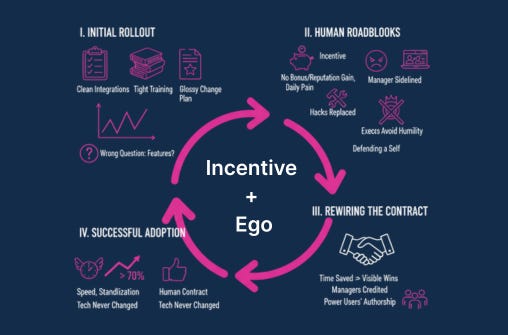FAVOR: If you enjoy our content, please subscribe here on substack, as well as our Podcast, PossibLaw on the various platforms. We greatly appreciate it!
You did the roadshow, bought the licenses, and wrote the playbook. Two months later, usage is stuck under 18%. The team nods in meetings, then routes around the tool. Nothing is broken technically. Something is broken humanly. The incentives and the egos.
My worst rollout looked perfect on paper: clean integrations, tight training, glossy change plan. Adoption flatlined anyway. I kept asking, “What feature is missing?” Wrong question. The real constraint was simple: nobody’s bonus, reputation, or daily pain improved by using it.
Then came the ego hits. A respected manager felt sidelined by the new workflow. Analysts saw their hard-won hacks replaced with templates. Executives wanted dashboards but not the humility of changing their own requests. Each person had a status story to protect. I was trying to sell a system. They were trying to defend a self.
Once we rewired the incentives and acknowledged the status math, everything moved. We tied time saved to visible wins, credited managers by name when teams hit milestones, and built a glide path that let power users keep authorship. Adoption crossed 70% six weeks later. The tech never changed. The human contract did.
The Real Constraint
Most implementations die where strategy meets identity. We measure features but people measure status, control, and reward. If your rollout plan ignores incentive and ego, you are asking humans to volunteer for loss. They will not.
Translate strategy to outcomes by aligning Incentive and Ego:
Map incentives explicitly: list who gains time, budget, credit, or optionality. Convert each gain into something countable: hours, dollars, deal velocity, error rate.
Make the win personal: tie adoption to performance reviews, OKRs, and public recognition. Show how the tool secures status, not just savings.
Reduce visible loss: preserve authorship where identity is strong. Let veterans name the templates, lead office hours, and appear on the release notes.
Price the alternative: quantify the cost of not changing. Missed SLA, rework hours, risk exposure. Put the number on a single slide everyone sees weekly.
Design for ego safety: create a no-blame runway. Pilot with friendlies, publish near wins, and frame adjustments as co-creation.
What to Say Out Loud
“Here is exactly how this helps the company hit earnings this quarter.”
“You will be credited by name for this win.”
“If you see a downgrade to your craft, we will change the design.”
“If we do nothing, we pay this cost every week.”
Remember, strategy without incentive is theater. Strategy without ego safety is sabotage. Make the right thing easy and the rewarding thing public.


